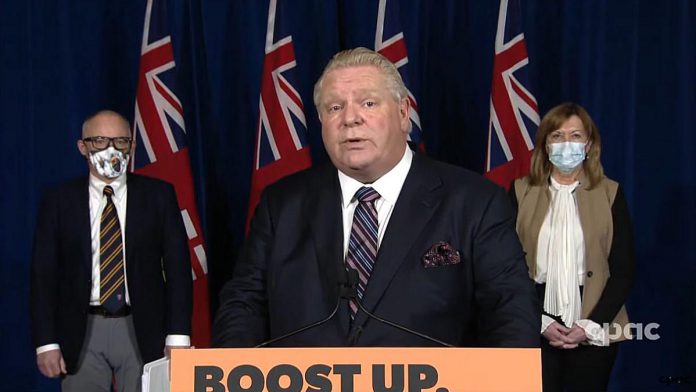
The Ontario government has announced the gradual lifting over the next six weeks of the COVID-19 public health restrictions implemented as a result of the omicron wave.
“Percent positivity has now dropped to 15.9 per cent, new admissions to hospitals are starting to slow, and patients are spending far less time in the hospital when admitted — and our health system workfroce is stabilizing, with more people coming back to work than calling in sick,” said premier Doug Ford in a media conference at Queen’s Park on Thursday (January 20), also attended by health minister Christine Elliott and chief medical officer of health Dr. Kieran Moore.
“As I said at the time, while necessary the additional measures were always intended to be time limited,” Ford added. “They were one more tool to blunt the spread of omicron and protect our hospitals. The evidence tells us that these measuers are working and that we can expect recent trendss to continue, as omicron cases peak this month.”
“While we can be confident in how far we’ve come, I want to be crystal clear — we’re not out of the woods yet,” Ford said. “The coming weeks will continue to pose real challenges, especially to our hospitals. But these are challenges our hospitals can manage. We can be confident in our ability to care for people, to provide hospital beds to those who need them, and we can be confident that the worst is behind us as we look to cautiously ease public health measures.
The removal of restrictions will take place in a phases approach, with 21 days between each step depending on trends in public health and health care indicators.
“Final recommendations on moving to each step will continue to be based on the recommendations of the chief medical officer of health, and we are committed to remaining cautious and responsive as we continue to respond to the omicron variant,” Elliott said.
As of January 31, social gathering limits will be increased to 10 people indoors and 25 people outdoors, capacity limits will be increased or maintained at 50 per cent in indoor public settings (including restaurants, bars, retailers, shopping malls, cinemas, gyms, meeting and event spaces, museums, galleries, zoos, casinos, bingo halls, and religious services), and spectator areas at sporting events, concert venues, and theatres will be permitted to operate at 50 per cent seated capacity or 500 people (whichever is less).
As of February 21, social gathering limits will be increased to 25 people indoors and 100 people outdoors, capacity limits will be removed for indoor public settings where proof of vaccination is required (including restaurants, gyms, and cinemas), and spectator areas at sporting events, concert venues, and theatres will be permitted to operate at 50 per cent capacity.
In most remaining indoor public settings where proof of vaccination is not required, capacity will be limited to the number of people that can maintain two metres of physical distance. For indoor religious services, rites or ceremonies, there will be no capacity limit if proof of vaccination is required.
In addition, indoor capacity limits in higher-risk settings where proof of vaccination is required (including nightclubs, wedding receptions in meeting or event spaces where there is dancing, as well as bathhouses and sex clubs) will be limited to 25 per cent.
As of March 14, social gathering limits will be increased to 50 people indoors with no limits for outdoor gatherings and social capacity limits will be lifted in all indoor settings, as well as from religious services, rites, or ceremonies.
In all steps, proof of vaccination requirements will continue to apply as well as other public health requirements such as masking.
According to the government, to manage COVID-19 over the long-term, local and regional responses by public health units may be deployed based on local context and conditions.
This story has been updated with additional details.


























